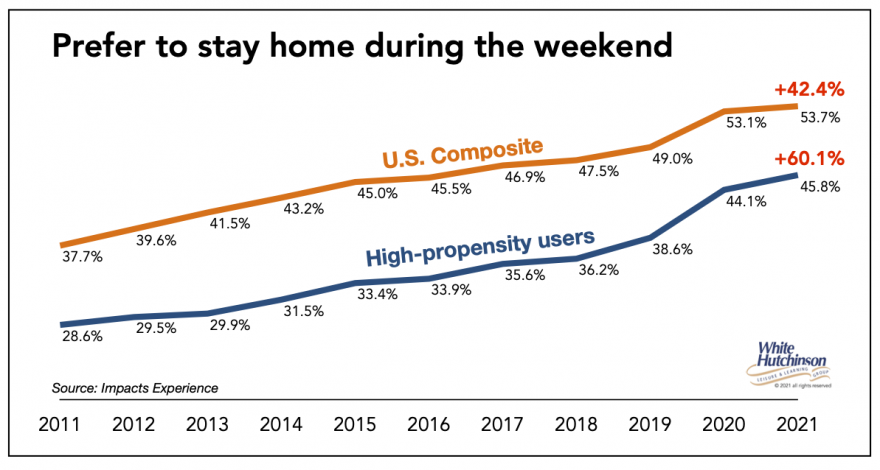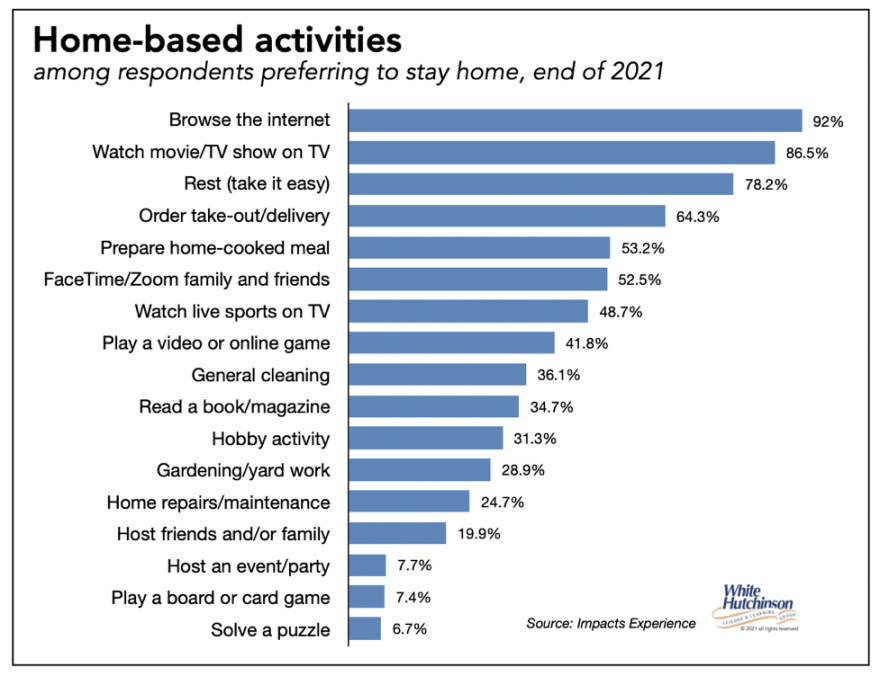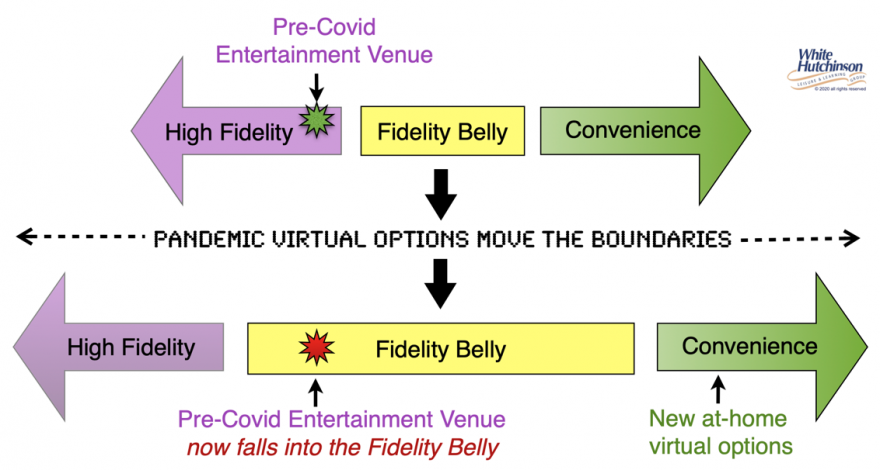
Vol. XXII, No. 4, April 2022
The couch is winning
In our article one year ago, The long-term stickiness of home nesting and the Fourth Place, we reported that the percentage of people preferring to stay home on the weekends when most out-of-home (OOH) leisure and entertainment activities take place has been on a steady increase over the years. In that article, we had data through the 3rd quarter of 2020.
We have new data on that trend through the middle of last year from Impacts Experience, compliments of Colleen Dilenscheider's excellent newsletter. The couch continues to get more competitive on the weekends with OOH leisure and entertainment activities. The chart below shows that the percentage of people who prefer to stay home over the weekend has grown by 16 percentage points, from 37.7% in 2011 to 53.7% last year.
Impacts Experience's research also looked at what they call high-propensity visitors to cultural venues, both exhibit and performance-based. This includes what you might call "hard-core" visitors as well as people who have a heightened interest in visiting. The percentage of high-propensity visitors who prefer to stay home on the weekends has increased by 17 percentage points, a staggering 60% increase from 28.6% in 2011 to 45.8% last year.

In her newsletter, Colleen said this: "Right off the bat, this isn't great news. A top indicator of a person willing to attend a cultural organization is that they are willing to leave their homes in the first place! As you can see, even the people who like to go out are more interested in staying in than they were in the past."
This is not good news for other types of OOH leisure and entertainment as well. They also continue to lose market share to all the at-home options people have, especially all their digital options. The pandemic probably exacerbated the trend of increasing at-home digital competition by introducing many people to new digital options that they learned to enjoy in the convenience of their homes out of necessity when they were forced to stay home. Remember, attending some OOH leisure or entertainment activity takes a lot of effort, getting dressed and getting there by some means of transportation. Therefore, it requires more time than just staying home with its options. For example, to watch a 2-hour movie at home only takes two hours, while going to the movie theater could easily consume three hours. And at home, you can stop the movie to get a snack or for a potty break. And at home option typically is far less expensive.
So, what are they doing when people stay home on the weekend? This is what Impacts Experience found when they asked people who said they prefer to stay home over the weekend what they did the last time they stayed home over the weekend.

Browsing the internet, watching a movie or show on TV, and "taking it easy" rank as the top three activities. Impacts Experience reports that these three items haven't changed much since they conducted the same research in 2017, with browsing the internet increasing. With more people staying home, more people are doing these activities.
It is also interesting to note that compared to 2017, there are several new options, or at least with more availability and options, such as ordering delivery meals. In 2017 the options might have been basically pizza and Chinese. Now you can even order gourmet meals and meals from just about every restaurant that exists. That, of course, creates competition for eatertainment designations, where the meal is part of the appeal. Now at home, we have delivered meals + digital entertainment. Zooming with family and friends is also a new option that replaces visiting some venue to socialize with them.
People make leisure and entertainment choices in terms of two key dimensions - the experience and its convenience. It's a trade-off between Fidelity, the quality of the experience, and Convenience - the ease of access in time, effort, and money. To win, you need to be at one extreme or the other of the Fidelity-Convenience continuum. Being in the middle means it falls into the Fidelity Belly and has no or little appeal. The more attractive just staying home on the weekends has become, along with the increased Convenience of all at-home digital screen-based entertainment and socialization now available, the higher the Fidelity an OOH experience needs to compete and attract people.
During the pandemic, digital entertainment and socialization dramatically improved in Convenience and appeal. The digital world evolved to become more meaningful and connected, replacing in-person experiences.
The continual growth of 4th Place virtual options and the coming metaverse will continue to dispute the perceived value of many OOH experiences. What used to be a pre-pandemic High Fidelity experience may no longer be considered High Fidelity due to all the improved at-home Convenience alternatives and will find itself in the Fidelity Belly. Today and in the future, to win, the quality of out-of-home leisure and entertainment experiences will need to be much higher than just two years ago.

Currently, many entertainment venues are experiencing a surge of attendance and revenues from pent-up demand as people venture out IRL and try to catch up on what they missed for so long due to Covid restrictions and concerns. Operators need to be careful not to mistake this for an established long-term trend of the increasing appeal of just staying home with the continual improvement of the Convenience of all the digital leisure and entertainment and other options people have at home. Today it has become the battle of the couch vs. OOH.


